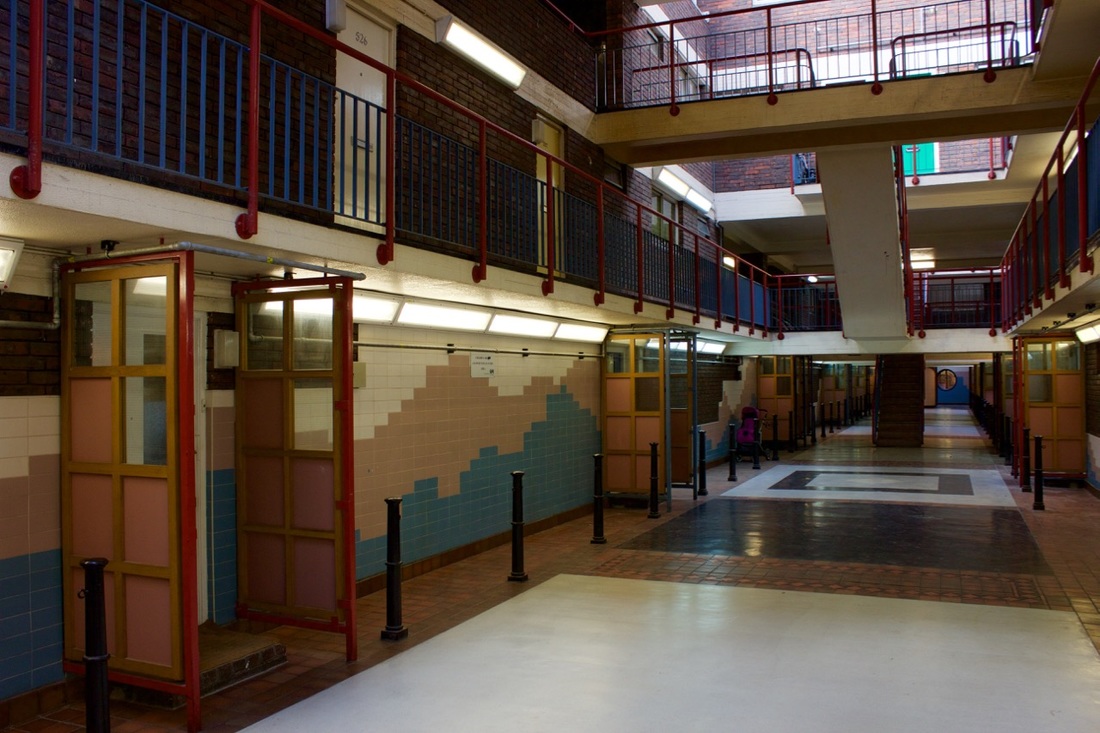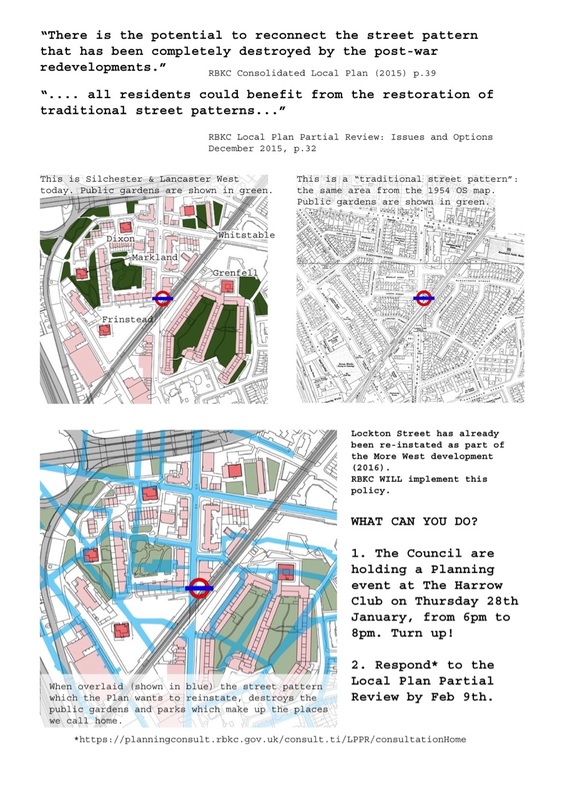|
It was a pleasure to meet up recently with Derek Latham at Lancaster West estate. He worked for the architectural firm of Clifford Wearden and Associates in the late 1960s making detailed drawings for Testerton, Hurstway and Barandon. These are the low rise housing units that radiate out from the central high rise tower and are known to locals as the "finger blocks". You might recall a previous blog featured Peter Deakins who was responsible for designing the early master plan. The planning and building process for Lancaster West was very protracted (1963-1981) and both architects left the practice before the first brick or concrete deck was layed They had different experiences and memories: Peter expressed frustration that the original plans were never built including a radical plan for building around Latimer station and connecting this with housing and a shopping centre; Derek campaigned about the housing crisis in North Kensington which the social housing development at Lancaster West was supposed to remedy. Ahead of out meeting, Derek kindly sent me his 1973 thesis: Community Survival in the Renewal Process - An integral part of the housing problem. This is very topical as RBKC council are currently consulting on a major regeneration at Silchester Estate and that will probably extend to Lancaster West in due course. The following are excepts from a statement provided by Derek and also an audio interview recorded at the estate. There are some fascinating comments about his involvement in the area and how it shaped the development of his philosophy of Gradual Renewal. "It’s wonderful to just come and experience the estate again. It was really interesting to see how the streets in the middle of the finger blocks have been altered and you feel they are ready for another transformation. So lovely to see that the green spaces between the blocks is just how we all envisaged it. The trees probably need thinning a little. Lovely in the winter, but in the summer I think there is probably just a bit too much shade. I have to say, the outside of the tower block with its new cladding looks really good and the academy is very impressive. At Lancaster West we tried to create scale and massing similar to that of a London Georgian square, but keeping the cars under the buildings so that the spaces between the building could be car free and provide a recreation and play space for those living around it. It was difficult to achieve the required density without building a series of tower blocks as was being undertaken on most other redevelopment schemes at the time. Our philosophy was effectively to lay tower blocks along the ground (in creating the "finger blocks") and instead of the vertical circulation going up the middle of the block by means of lifts, the circulation went along the centre of the block horizontally by means of walkways. During the development I became concerned when I discovered that a large proportion of the existing tenants who lived in the area were not to be rehoused. This was because they were effectively itinerant tenants living in the Rachman owned properties. Often two families to a floor sharing a kitchenette and sometimes six families sharing one bathroom and toilet. We think housing conditions today are poor, but I wish I had the photographs to show you the appalling conditions that these people were living in. They truly were slums. Not because of the way they were originally built as fine townhouses for single families with their servants but because of the way they were being exploited with little maintenance and severe overcrowding as the housing shortage at that time was so acute. You could look at a film like Cathy Come Home which was made back in the 1960s which fully explains the situation at that time. Because of my concern at the situation I joined Shelter. But I could do nothing to help the families that were in the Lancaster Road West area, most of whom had already been moved out to create a "ghost town". In fact the area was used as a film set just before it was demolished. All the buildings were painted black to create a macabre backcloth for some form of thriller or horror film. I am sorry, but I cannot remember the name of the film - I never did see it. (Derek is referring to the 1969 film, Leo The Last). But the council's intention was to continue with the demolitions northward into the Golborne area. It was in this area that we worked with shelter to encourage the residents to fight for their rights and fight for the properties to be improved under the new housing improvement acts rather than demolished. This was action that was taken directly to both the GLC and the borough. I remember one occasion when the borough said it was too complicated to change from demolition to improvement and the protesters wrapped up the Mayor's car in red tape. Shelter had also fought against the construction of Westway. There was a political party at that time called Homes Before Roads which actually managed to get some councillors elected onto the GLC. There was another occasion I recall when some activists in the upper stories of the houses in Golborne that were so close to the road demonstrated their proximity by firing with air rifles at the tyres of the cavalcade of cars that drove along Westway when it was opened causing several punctures. People were a lot more active with their politics in those days. By this time I was passionate about the need for a better solution to housing regeneration than the large clearances that were occurring throughout all the major cities in Britain. My thesis had examined the large council estates in Glasgow (Balornack Road Estate) , Liverpool and Manchester. But it also examined innovative improvement schemes rescuing tenement blocks in Glasgow, back-to-back houses in Leeds, and community housing in Liverpool 6 under something called the Shelter Neighbourhood Action Programme (SNAP), as well as some housing improvement being undertaken in Wandsworth by Ted Hollamby in the Brixton area. These demonstrated that communities survived better through the redevelopment process if they could remain where they were. Hence I developed the philosophy of Gradual Renewal - simply removing the very worst of the houses that were in poor condition and replacing them on the same street with new houses fitted in between those that remained. The philosophy was that in 15 or 20 years when some more of the original houses reached the end of their economic life then these too could be replaced. This would utilise the hammer and chisel and a small-scale builder rather than the bulldozer and the tower crane. It would avoid the decade of disruption that occurs with clearance and redevelopment. When I was first involved at Lancaster West, there was no question that you just pulled slums down. They had been doing it since the 1930s and it was very important because in those days the houses were really badly built. There aren’t slums now. There are estates which have been vandalised, but more often neglected. Maybe because they are more expensive to look after than other estates, so they don’t get that extra money. But in the long term maintaining places is cheaper than pulling them down and rebuilding them. And that’s without taking into account social costs. In my experience the disruption to the community is usually not less than 10 years from the start of a development to its end. This is a good part of any child’s life. What are the consequences of that? They are enormous and they don’t get costed. That’s why to keep communities together, you need to make the change frequent but small scale. And to have a long term vision for slow redevelopment in stages. But the idea of wholesale redevelopment, running everything to the end of its life, is going to cause problems for people. I don’t know about the condition of Silchester estate but Lancaster West is good solid brick work construction. It's not some panels that are held together with rusting joints. I know in some cases quite a lot of the GLC housing estates had that inherent problem and that was never going to get resolved. You just have to say we cannot repair it. It if hasn’t got those sort of problems, why not find a way of achieving your objectives without pulling everything down. The principal should be to save and find ways of improving. How can we build an extra floor if we want to increase the density? How can we improve the walkways or insulation? Sometimes you might need to demolish certain portions. I wouldn’t be alive now without some pretty good surgery from time to time. But the point about the good surgeons is that they only cut the bits that absolutely ned to be cut and the rest of the organ keeps going. And if you look at any community estate, it's like a living being and will need some surgery. But surgery isn’t death by bludgeoning and waiting for a re-birth. Nobody survives that well. The current housing crisis is bonkers. It’s clearly about not building enough houses because they haven’t worked out a way to fund it. And I don’t fully understand it. There is a lot of capital tied up in this country and basically its not quite needing a PFI because that is for too heavy. All you need, in my view, is to give a reasonable tax break and guaranteed longevity to major institutions to be able to invest in housing. It is a lot of investment and it needs a long pay back period. It’s not a quick fix. But if you get it right, it should be a good fix. Social housing should have a stability to it that even private housing doesn't. People like the Peabody Trust can demonstrate how it's done. I can’t understand why the government has not taken that model and gone with it. Although it's a Fabian model, it still fits very strongly within the conservative ethic of using private finance to help people to do things and to see it as a long term investment. You could progressively allow a proportion of houses to be purchased each time as long as that money is recycled into the new houses. But that's got to be sustainable and they have never seemed to be able to get the model to work. " Campaigning poster designed by Dale Teller and circulated by We love the Silchester Estate.
0 Comments
Leave a Reply. |
Categories
All
Archives
May 2024
|







 RSS Feed
RSS Feed
